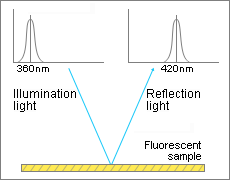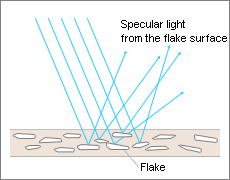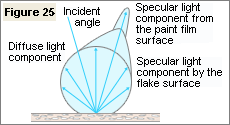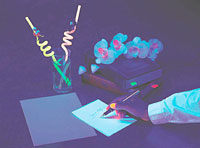Precise Color Communication
 |
 |
When you see a fluorescent color, it looks like it is glowing by itself although it is not actually a light source.
When light is applied to a fluorescent material, the rays are absorbed and re-emitted as visible light in other regions of
the spectrum, usually at longer wavelengths. As explained in
Part II-2
, the visible light region is
electromagnetic radiation between 380nm and 780nm. For example, when 360nm radiation is absorbed and emitted at 420nm,
the measurement value at 420nm may exceed 100%. Since more than the expected amount of light is visible,
it appears to the human eye as if the material glows by itself. For measurement of non-fluorescent samples,
the dispersive element can be placed either between the source and the sample or between the sample and the receiver.
However for the measurement of fluorescent samples to agree with the color as it appears to people,
the dispersive element must be placed between the sample and the detector so that the sample is illuminated
by the entire spectrum of the source. When a fluorescent color is measured by the spectrophotometer,
the spectral power distribution of the light source, including the ultraviolet regions, must be controlled.
|
 |
Many coatings, especially in automotive applications, use a combination of metallic flakes
and colorant to achieve a colorful effect. In a metallic coating, light is reflected at different angles
due to the orientation of the flakes of metal in the coating, although the flakes will generally be aligned
in the same direction. Figure 25 illustrates how the specular reflectance and diffuse reflectance interact
with a metallic coating. Because the color reflects from the metallic flake at a different angle than
the diffuse reflectance, the appearance to the human eye will also differ. At the angle close to
the specular reflection, highlight color (face), which is influenced by the metallic flake, is seen.
At the angle, which is not influenced by metallic flake, shade color (flop), is seen. In general,
when measuring metallic colors, it is more effective to measure and evaluate them with a spectrophotometer
that measures color at multiple angles.

|
|
|||||||
| 3/4 | ||
|
|



